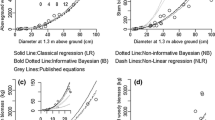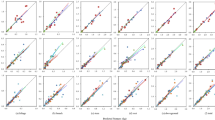Abstract
Fractal branching models can provide a non-destructive and generic tool for estimating tree shoot and root length and biomass, but field validation is rarely described in the literature. We compared estimates of above ground tree biomass for four indigenous tree used on farm in the Philippines based on the WanFBA model tree architecture with data from destructive sampling. Allometric equations for the four species varied in the constant (biomass at virtual stem diameter 1) and power of the scaling rule (b in Y = aD b), deviating from the value of 8/3 that is claimed to be universal. Allometric equations for aboveground biomass were 0.035 D 2.87 for Shorea contorta, 0.133 D 2.36 for Vitex parviflora, 0.063 D 2.54 for Pterocarpus indicus and 0.065 D 2.28 for Artocarpus heterophyllus, respectively. Allometric equations for branch biomass had a higher b factor than those for total biomass (except in Artocarpus); allometric equations for the leave + twig fraction a lower b. The performance of the WanFBA model was significantly improved by introduction of a tapering factor “τ“ for decrease of branch diameter within a single link. All statistical tests performed on measured biomass versus biomass predicted from the WanFBA results confirm the viability of the WanFBA model as a non-destructive tool for predicting above-ground biomass equations for total biomass, branch biomass and the leaf + twig fraction.




Similar content being viewed by others
References
Araujo TM, Higuchi N, De Carvalho JA (1999) Comparison of formulae for biomass content determination in a tropical rain forest site it the state of Pará. Brazil. For Ecol Manage 117:43–52
Brown IF, Martinelli LA, Thomas WW, Moreira MZ, Ferreira CAC, Victoria RA (1995) Uncertainty in the biomass of Amazonian forests: an example from Rondonia, Brazil. For Ecol Manage 75:175–189
Fownes JH, Harrington RA (1991) Allometry of woody biomass and leaf area in five tropical multipurpose tree species. Trop For Sci 4(4):317–330
Huxley A (1932) In: MacVeagh L (ed) Problems of relative growth. The Dial Press, New York, p 276
Ketterings QM, Coe R, van Noordwijk M, Ambagau Y, Palm CA (2001) Reducing uncertainty in the use of allometric biomass equations for predicting above-ground tree biomass in mixed secondary forest. For Ecol Manage 146:201–211
Loage K, Green RE (1991) Statistical and graphical methods for evaluating solute transport models: overview and application. J Contam Hydrol 7:51–73
Mulia R, Purnomosidddhi P, Lusiana B (2001) Tree parameterization in WaNuLCAS model. International Centre for Research in Agroforestry, Bogor, Indonesia
Nelson BW, Mesquita R, Pereira JLG, Aquino de Souza SG, Batista GT, Couto LB (1999) Allometric regressions for improved estimate of secondary forest biomass in the central Amazon. For Ecol Manage 117:149–167
Nogueira EM, Fearnside PM, Nelson BW, Franca MB (2007) Wood density in forests of Brazil’s ‘arc of deforestation’: implications for biomass and flux of carbon from land-use change in Amazonia. For Ecol Manage 248:119–135
Ola-Adams BA (1997) Assessment of three allometric regression techniques of biomass determination in two hardwood species. Trop For Sci 9(3):321–328
Ozier-Lafontaine H, Lecompte F, Sillon JF (1999) Fractal analysis of the root architecture of Gliricidia spium for the spatial prediction of root branching, size and mass: model development and evaluation in agroforestry. Plant Soil 209:167–180
Padrón E, Navarro-Cerrillo RM (2004) Estimation of above-ground biomass in naturally occurring populations of Prosopis pallida (H.&B. ex. Willd.) H.B.K. in the north of Peru. J Arid Environ 56:283–292
Pages L, Asseng S, Pellerin S, Diggle A (2000) Modeling root system growth and architecture. In: Smit AL, Bengoungh AG, Engels C, van Nordwijk M, Pellerin S, van de Geijn SC (eds) Root methods, a handbook. Springer, Berlin, pp 113–146
Parresol B (1999) Assessing tree and stand biomass: a review with examples and critical comparisons. J For Sci 45(4):573–593
Roshetko JM, Evans DO (1999) Domestication of agroforestry trees in Southeast Asia. Forest, farm, and community tree research reports. World Agroforestry Centre. Southeast Asia Regional Research Programme, Bogor, Indonesia
Rowe EC (1999) The safety-net role of tree roots in hedgerow intercropping systems. PhD Thesis, Wye College, University of London, UK, pp 288
Rykiel EJ (1996) Testing ecological models: the meaning of validation. Ecol Modell 90:229–244
Santos-Martin F, van Noordwijk M (2009) Trade-offs analysis for possible timber-based agroforestry scenarios using native trees in the Philippines. Agroforest Syst 76:555–567
Smith DM (2001) Estimation of tree root lengths using fractal branching rules: a comparison with soil coring for Grevillea robusta. Plant Soil 229:295–304
Tyree MT, Sperry JS (1989) Vulnerability of xylem to cavitation and embolism. Annual review of plant physiology and plant molecular biology 40:19–36
van Noordwijk M (1999) Functional branch analysis to derive allometric equations of trees. In IC-SEA No. 6. Modelling global change impacts on the soil environment. International Centre for Research in Agroforestry (ICRAF), Bogor, Indonesia
van Noordwijk M, Lusiana B (1999) WaNulCAS a model of water, nutrient and light capture in agroforestry systems. Agrofor Syst 43:217–242
van Noordwijk M, Mulia R (2002) Functional branch analysis as tool for scaling above and belowground trees for their additive and non-additive properties. Ecol Modell 149:41–51
van Noordwijk M, Spek LY, Willigen P (1994) Proximal root diameter as predictor of total root size for fractal branching models. Plant Soil 164:107–117
van Noordwijk M, Lusiana B, Khasanah N (2004) WaNuLCAS version 3.1, Background and a model of water nutrient and light capture in agroforestry systems. International Centre for Research in Agroforestry (ICRAF), Bogor, Indonesia, p 246
West GB, Brown JH, Enquist BJ (1999) A general method for the structure and allometry of plant vascular systems. Nature 400:664–667
Acknowledgments
This study was conducted within the framework of the Smallholder Agroforestry Options on Degraded Soils (SAFODS), EU funded project (No: ICA4-CT-2001-10092), in close collaboration between the Forestry Department from University of Cordoba (Spain) and the World Agroforestry Centre (ICRAF). We also thank for their constructive comments and suggestions to Betha Lusiana, Ni′matul Kashana and Degi Harja Asmara.
Author information
Authors and Affiliations
Corresponding author
Rights and permissions
About this article
Cite this article
Santos Martin, F., Navarro-Cerrillo, R.M., Mulia, R. et al. Allometric equations based on a fractal branching model for estimating aboveground biomass of four native tree species in the Philippines. Agroforest Syst 78, 193–202 (2010). https://doi.org/10.1007/s10457-009-9271-5
Received:
Accepted:
Published:
Issue Date:
DOI: https://doi.org/10.1007/s10457-009-9271-5




